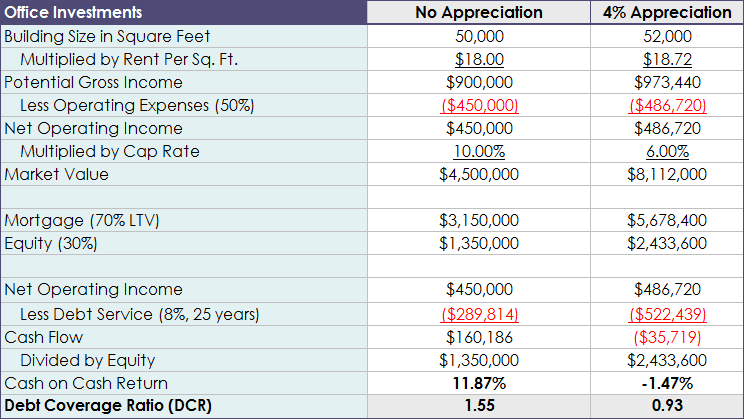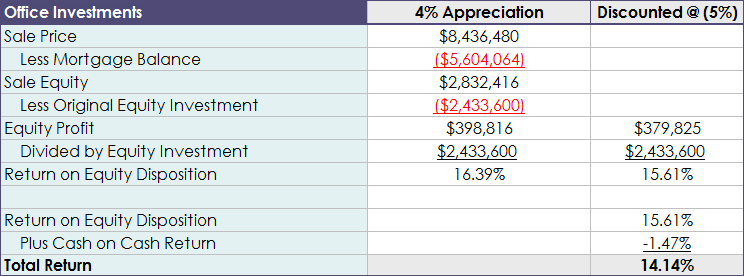So the theory goes that, say, an investor wishing a 10 percent return with an expectation of 4 percent appreciation would buy a property for a 6 percent cap rate. Let’s test it out.
What a difference a 4 percent appreciation factor made! The cash on cash return went rogue and so did the debt coverage ratio. Still, loans were made with 6 percent cap rates in many parts of the country at and before the top of the market.
What we see is that all return on investment is now back-loaded, meaning it all happens when the property has sold. Sounds very familiar, doesn’t it? Up to this point we’ve only considered the cash on cash return. Now let’s calculate and add in the back-loaded profit when the asset is sold. To do so, let’s assume the property is sold at the same cap rate it was bought for and that the property appreciated 4 percent after it was acquired (remember that it was acquired with a built-in cap rate expectation, so it’s realized; $7,800,000 x 1.04 = $8,112,000). Let’s even go so far as to leave out all sale expenses like closing costs and brokerage. The reason I’m omitting these is that we’re talking about acquisition analysis and most investors worry about disposition after they’ve bought the property, not before the purchase is done. ‘Kind of a cart before the horse thing. Here are the results.
‘Most interesting. The return on selling the asset given the same 4 percent appreciation assumptions applying to the next investor produces a substantially higher return than the no appreciation scenario (16.39 percent versus 11.87 percent). Of course I had to discount the results because the sale occurs one year into the future and the point of all this is to considering the cap rate appreciation factor on the day of acquisition, not disposition. Even after you subtract the negative cash on cash return for the year the asset is held, your total return is still well above the no appreciation scenario (14.00 percent versus 11.87 percent).
Hmmm… Houston, we have a problem. Going back to Part 1:
In evaluating a property for acquisition, the investor is told by a real estate advisor that the expected appreciation rate for the property is estimated at about 3%. Given the total return requirement of 12%, the investor will buy the property only if it is priced so that it offers a 9% (twelve percent minus three percent) income return, at least.
So what the author is saying is that the total return at a 10 percent cap rate is equal to the total return of a 6 percent cap rate with a 4 percent expected appreciation factor. In other words, the total return of 14.00 percent in the 6 percent cap rate plus 4 percent appreciation scenario should equal the total return of 11.87 percent for the 10 percent no appreciation scenario. Numerically, we’ve proven that this is not correct (the gap is wider if you exclude discounting, although smaller if you factor in closing costs).
We all know cap rates decline in hot real estate markets. We know that there is an appreciation expectation built into the low cap rates. Quantifying it, however, isn’t that simple. Let’s keep it that way.



